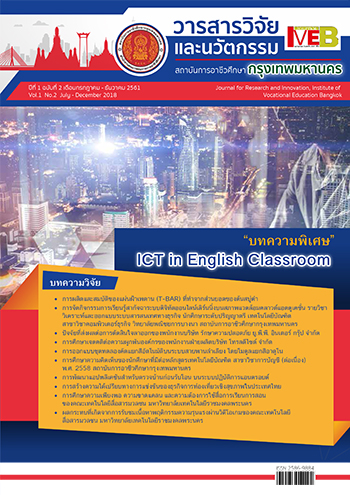ICT in English Classroom
Main Article Content
Abstract
“Technology can become the “wings” that will allow the educational world to fly farther and faster than ever before—if we will allow it.” - Jenny Arledge. In today’s world using technology is something undeniable; almost everything needs technology especially in educational field. Information and Communication Technology (ICT) plays a key role in language education, specifically on English learning and teaching. That is why this paper aims to outline some of the crucial impacts ICT has on English language teaching and learning. It includes the role of ICT as resources for both teacher-centered resources and student-centered resources. It, furthermore, explains what sources are best for students and teachers and where they can find those. This paper also focuses on the incorporation of ICT in helping enhance four basic language skills which are listening, speaking, reading and writing and the basic areas of language teaching include grammar and vocabulary which helps learners acquire efficiency in the language. The last part of this paper will elaborate how ICT promotes learners’ motivation and participation in learning.
Article Details
References
Nomass, B. B. 2013. The impact of using technology in teaching English as a second language. English Language and Literature Studies, 3(1), 111.
Huang, Y.-N., & Hong, Z.-R. 2015. The effects of a flipped English classroom intervention on students’ information and communication technology and English reading comprehension. Educational Technology Research and Development, 64(2), 175-193. doi: 10.1007/s11423- 015-9412-7
Herlina, A. 2014. The Utilization of Technology to Improve English Speaking Skills. Journal for the Study of English Linguistics, 2(2), 19. doi: 10.5296/jsel.v2i2.6665
Martins, C. B. M. J., Steil, A. V., & Todesco, J. L. 2004. Factors influencing the adoption of the Internet as a teaching tool at foreign language schools. Computers & Education, 42(4), 353-374. doi:10.1016/j.compedu.2003.08.007
Ali, M. 2016. Application of ICT in English Language Teaching in Bangladesh: Prospect, Problems and Solution. ASA University Review, 10(1).
Chu, S. K. W., Zhang, Y., Chen, K., Chan, C. K., Lee, C. W. Y., Zou, E., & Lau, W. (2017). The effectiveness of wikis for project-based learning in different disciplines in higher education. The Internet and Higher Education, 33, 49-60. doi: 10.1016/j.iheduc.2017.01.005
Xuan Thu Dang, H. N. 2012, May 26. USING INTERNET RESOURCES TO TEACH LISTENING AND SPEAKING. ICTEV2012 Creative Connection State Conference. Melbon.
Schoepp, K. 2001. Reasons for using songs in the ESL/EFL classroom. The internet TESL journal, 7(2), 1-4.
Aydin, S. 2016. WebQuests as language-learning tools. Computer Assisted Language Learning, 29(4), 765-778.
Al-Awidi, H. M., & Ismail, S. A. 2014. Teachers’ perceptions of the use of computer assisted language learning to develop children’s reading skills in English as a second language in the United Arab Emirates. Early Childhood Education Journal, 42(1), 29-37.
Momani, M. M., Al Farhan, A. A., & mohammed Al Qarni, H. 2015. THE FREQUENCY OF ENGLISH LANGUAGE TEACHERS USING SOME INTERNET APPLICATIONS IN TEACHING READING COMPREHENSION SKILLS. European Scientific Journal, ESJ, 11(13).
Buckingham, L., & Alpaslan, R. S. 2017. Promoting speaking proficiency and willingness to communicate in Turkish young learners of English through asynchronous computer- mediated practice. System, 65, 25-37. doi: 10.1016/j.system.2016.12.016
Manurung, K. 2015. Improving the Speaking Skill Using Reading Contextual Internet-based Instructional Materials in an EFL Class in Indonesia. Procedia - Social and Behavioral Sciences, 176, 44-51. doi: 10.1016/j.sbspro.2015.01.442
Md Yunus, M., Nordin, N., Salehi, H., Amin Embi, M., & Salehi, Z. 2013. The Use of Information and Communication Technology (ICT) in Teaching ESL Writing Skills. English Language Teaching, 6(7). doi: 10.5539/elt.v6n7p1
Drigas, A., & Charami, F. (2014). ICTs in English Learning and Teaching. International Journal of Recent Contributions from Engineering, Science & IT (iJES), 2(4), 4. doi: 10.3991/ijes.v2i4.4016
Su, C.-Y. 2017. Investigating the Effectiveness of an Interactive IRF-Based English Grammar Learning System. International Journal of Emerging Technologies in Learning (iJET), 12(11), 63-82.
Ahmad, K. S., Armarego, J., & Sudweeks, F. 2017. The Impact of Utilising Mobile Assisted Language Learning (MALL) on Vocabulary Acquisition among Migrant Women English Learners.
Hashim, H. H. Utilizing ICT to Promote Motivation towards Language Learning among. Utilizing ICT to Promote Motivation towards Language Learning among.
Papastergiou, M. 2009. Digital Game-Based Learning in high school Computer Science education: Impact on educational effectiveness and student motivation. Computers & Education, 52(1), 1-12. doi: 10.1016/j.compedu.2008.06.004
Kostaris, C., Sergis, S., Sampson, D. G., Giannakos, M. N., & Pelliccione, L. 2017. Investigating the Potential of the Flipped Classroom Model in K-12 ICT Teaching and Learning: An Action Research Study. Educational Technology & Society, 20(1), 261–273
Tsai, C.-H., Cheng, C.-H., Yeh, D.-Y., & Lin, S.-Y. 2016. Can learning motivation predict learning achievement? A case study of a mobile game-based English learning approach. Education and Information Technologies, 22(5), 2159-2173. doi: 10.1007/s10639-016-9542-5
Dogoriti, E., & Pange, J. 2013. Considerations for Online English Language Learning: The Use of Facebook in Formal and. The Social Classroom: Integrating Social Network Use in Education: Integrating Social Network Use in Education, 147.
Al Awani, A., Senteni, A., & Singh, A. D. 2016. An Investigation About the Usage and Impact of Digital Video for Learning. Paper presented at the ECEL 2016-Proceedings of the 15th European Conference on e-Learning.


